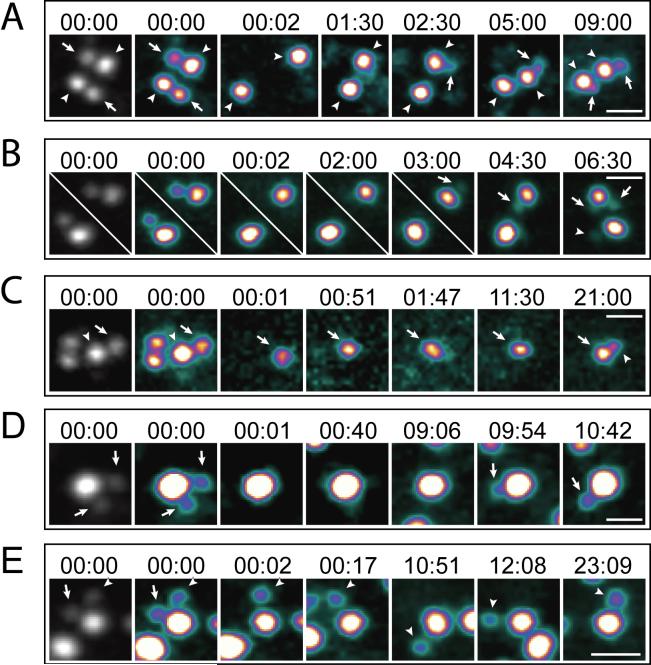Figure 3.
Ablation of all daughter centrioles within a centrosome induces reduplication of the mother in S-phase arrested CHO cells. (A) In this cell, daughter centrioles in both diplosomes were ablated (arrows in 00:00). Both mother centrioles (arrowheads) remained single for more than 1 hr. Then, one of the mothers developed a new daughter (arrow in 02:30), while the second mother remained single. Approximately 9 hr after ablation, the second mother also developed a new daughter centriole (arrow in 09:00). (B) An example of triplosome formation after ablation of the original daughter centriole. Both daughter centrioles were ablated, as in (A). However, one of the mothers in this cell developed two daughter centrioles (arrows in 03:00, 04:30, and 06:30). Formation of the two daughters was not simultaneous. However, at later time points the two daughters appeared to be of the same size (not shown). The second mother developed a single daughter centriole (arrowhead in 06:30). (C) In this cell the mother centriole in one of the diplosomes was ablated (arrowhead). Because the daughter and mother centrioles can undergo natural disengagement during the course of >20-hr long experiments, which complicates the analysis, the second diplosome was also completely ablated. As the result, the cell was left with just one daughter centriole (arrows). This centriole remained single for more than 11 hr but ultimately developed a daughter (arrowhead in 21:00). (D) Both daughters within a triplosome (arrows in 00:00) were ablated. The mother remained a single centriole for ∼9 hrs and then developed a new daughter (arrows in 09:54 and 10:42). (E) Just one of the two daughters in a triplosome was ablated (arrows in 00:00) converting this triplosome into a diplosome. The other daughter centriole (arrowhead) remained engaged with the mother for more than 24 hrs, and the ablated daughter did not regenerate. Time stamps in hours : minutes. Scale bars = 1 μm. Same LUT as in Fig.1.

